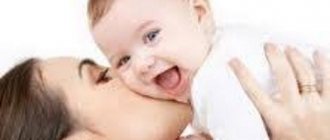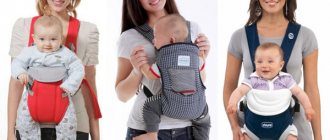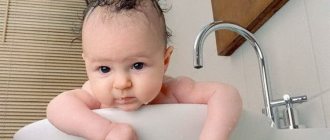All young parents need to know how to properly raise a child from birth. The opinion that it is necessary to raise a baby at the moment when he is already walking and talking is quite erroneous. It is on what foundation is laid in the child’s character in the period up to 1 year that his further development and perception of the world and society will depend.
Conventionally, the development of a baby in the first year of life is divided into 4 stages, each lasting 3 months. One can only imagine how much effort it will take for a baby to learn so much in just 1 year. Therefore, a huge responsibility falls on the shoulders of parents; advice from pediatricians and child psychologists will help here.
Period from birth to 2.5-3 months
In the first three months of life, the leading ones that determine the development of the child are visual, auditory and emotional reactions. They make it possible to form active wakefulness, ensure the child’s sensory development, expand his orientation in the environment, promote the development of hand movements, and subsequently general movements. Thanks to a positive emotional state, physiological processes (breathing, blood circulation, digestion) improve and overall activity increases. A child is born with a ready-made system of unconditioned reflexes, which partially ensure his adaptation to the external environment. These are orienting reflexes, food, visual, auditory, etc. Unconditioned food reflexes are expressed in the appearance of sucking movements when the lips and oral cavity are irritated, in the ability to swallow, etc. The main reflexes of the visual and auditory analyzer are manifested in closing the eyes in bright light, shuddering with sharp sounds. Some reflexes of the vestibular apparatus are also innate, for example, when rocking, the child calms down and calms down. A newborn does not have a sharp boundary between sleep and wakefulness: he sleeps 80% of the time of the day, and worries when he wakes up. The movements of the newborn are chaotic. Even during sleep he makes impulsive movements. The newborn's arms and legs are bent and pressed to the chest because the extensor muscles are not developed enough. The development of the visual and auditory analyzer is essential during the neonatal period. At this age, the child does not yet know how to fix his gaze on objects for a long time, and he perceives an object more easily if there are no other stimuli in his field of vision. Therefore, a child in the first month of life should be shown one bright toy, and not garlands of multi-colored rattles. The ability to fix the gaze on an object, concentrate on it, and listen to sounds develops in a child with proper upbringing towards the end of the newborn period. At the same time, convergence is formed - the ability to bring the visual axes of both eyes together on an object. By 2-3 months, children get used to following a moving object and everything that happens in their field of vision; they react to an invisible source of sound, for example, turning their heads towards a voice. In order to develop visual and auditory reactions in a child during the first three months of life, they talk to him affectionately, achieving concentration on the adult’s face; They show a bright toy and slowly move it in front of the child’s eyes to cause tracking of the object’s movement. Children are usually awake in the playpen; Bright large rattles are hung on the playpen stand at a distance of 40-60 cm from the child’s eyes. From time to time you should set the toy in motion so that the child learns to follow it. The development of visual and auditory concentration contributes to the emergence of positive emotions in the baby. A smile appears at the end of the first month of life in response to the gentle voice of an adult. At first it occurs rarely, with difficulty. At 2.5 months, the child already smiles often and shows joy at the sight of an adult and toys. By this age, the baby’s expression of joy takes the form of a complex of animation. The revitalization complex includes a number of reactions: emotional - a smile, vocal - sounds, motor - movements of the arms and legs. The child's vocal reactions, included in the revitalization complex, are expressed in the form of hooting - abrupt pronunciation of the consonant sounds gee, kha. Humming, which occurs against the background of a positive emotional state, serves as a preparatory stage in the development of speech. In the first 2.5-3 months, the child begins to develop movements. If a 4-6 week old baby is held in his arms during quiet wakefulness and, supporting his back and head, is given a vertical position, then by 2 months he will master the ability to hold his head in this position and examine his surroundings. From 1.5 months, the child should be taught to lie on his stomach. For this purpose, before feeding or at the end of wakefulness, the child is placed on his stomach and lightly stroked on the back. By 3 months, he is already lying well on his stomach, leaning on his forearms, raising his head high. This position is useful for developing breathing movements, blood circulation, and also for preparing for crawling. A child who has mastered the ability to hold his head in an upright position should develop leg support: the baby is held in an upright position so that his legs are in contact with the playpen or changing table, thereby causing dancing movements. However, you can’t put it on its feet yet.
Raising a child from 1 to 3 months
The first stage of child development lasts from the moment of birth until he is 3 months old. It is at this time that it is very important to help the child get used to the world around him, hygiene, and teach him the first skills of communication and sensory perception.
In the first weeks of life, the baby needs nothing more than satisfaction of hunger, good health and sound sleep. However, then there comes a moment when, in addition to basic desires, the child begins to look around, studying and observing. It is important from now on to teach him to contemplate everything with his head held high, for which you need to turn him over on his stomach, even if this causes protest. Over time this will become a good habit.
Particular attention must be paid to hygiene. Already from the cradle, you need to teach your baby to wash his face every morning. Even a simple diaper change will gradually accustom the child to cleanliness, and over time he himself will show that it is time for hygiene procedures.
The ability to speak is necessarily included in the development and upbringing of young children. To do this, all procedures must be accompanied by gentle conversations and humming songs. Each of your actions needs to be voiced, commented on, and told what is happening to him right now. A smile in conversation will lay the foundations of a culture of communication and will make the child happier.
We must not forget that from birth it is necessary to teach the baby to be independent. To do this, you need to accustom him to being alone in the crib for some time, cooing and playing with his first toys. Hanging carousels are perfect for this, as they both entertain and develop a child’s visual and sensory skills.
Period from 2.5-3 to 5-6 months
In children of this age, visual, auditory and vocal reactions improve; grasping movements of the hand and preparatory movements for crawling arise and develop. All this serves as a prerequisite for a stable emotional-positive state, the emergence of attachment to adults, and the subsequent formation of a variety of objective actions and basic movements. During this period, significant changes occur in the child’s mental development: the ability to differentiate sounds, colors and shapes of objects develops. The distinction between objects and phenomena of the external environment is especially pronounced in the selective attitude towards adults. If the child’s senses are actively developing, then already a three-month-old baby begins to recognize his mother, and at 6 months, when he sees a familiar person, he rejoices, when he sees a stranger, he frowns, turns away, and sometimes cries. A child of 5-6 months distinguishes the intonation of an adult’s speech and reacts differently to a stern or affectionate voice. So, a baby may cry if someone speaks to him in a harsh tone. To develop in children the ability to distinguish between environmental stimuli, it is necessary to select toys of different colors and shades, different shapes and different sounds. By encouraging the child to look at such toys and listen to the sounds they make, adults promote his sensory development. Further development of the activity of the visual and auditory analyzers occurs in the process of the child’s manipulation with objects and emotional communication with adults. However, in order for his hearing to develop normally, a favorable acoustic environment is necessary in the room where children are awake. Loud conversation, screaming from other children, constantly playing radio - all this not only interferes with the development of hearing, but also inhibits the development of speech and disrupts the activity of the nervous system. A baby who is not accustomed from the first months of life to listen to the quiet voice of an adult will only respond to loud sounds and a raised tone. The development of the child’s hearing, positive emotions, articulatory apparatus (when pronouncing short guttural sounds, hooting) contributes to the emergence of a melodious hum at 4-5 months (the vowel a-a-a and the combination of sounds a-gu is pronounced in a chant manner), and at 6-7 months - babble (so-called repeated syllables: repeated pronunciation of one syllable - ba-ba-ba). The melodious sounds of humming are pronounced with a long exhalation, which contributes to the formation of speech breathing. Babbling usually occurs under the control of hearing, which is why children who are congenitally deaf do not have it. A prerequisite for the appearance of humming and babbling sounds in children is the emotional and verbal communication of an adult with them. At the same time, when talking with children 3-4 months old, you should use melodious sounds, with children 5-6 months old - syllables. There should be relative silence in the group room so that purposeful speech communication between an adult and a child increases the vocal activity of all children in the group and contributes to their imitation of speech sounds. A prerequisite for the timely development of speech is the formation in the child of a need for verbal communication. Already at 4-6 months, children use their ability to pronounce sounds to attract the attention of an adult. Classes on the development of vocal reactions should be carried out individually, although it is possible to combine 2-3 children with the same level of development. During the lesson, different techniques can be used sequentially: emotional-verbal communication, showing a toy in combination with affectionate conversation, the silent presence of an adult, repeated emotional-verbal communication. Between each technique used, you need to pause (about 30 seconds) to allow the child to react. This activity can last up to 6 minutes. If during a lesson the teacher confines himself to only affectionate conversation, then its duration should not exceed 3 minutes, since the child gets tired of the monotony of impressions. Children aged 3-6 months gradually develop hand movements. At 3-3.5 months, the child usually accidentally bumps into a toy suspended low above him. At 3.5-4 months, he grasps and feels a toy hanging at arm's length. At 4.5-5 months, accepts a toy from the hands of an adult. At 6 months, the child can freely pick up the toy himself. To develop the baby’s ability to grasp and hold an object, first they hang small toys that are easy to grasp: rattles with balls on a ring. At 4-4.5 months, an adult teaches a child to take a toy from his hands. To do this, he brings a rattle to the child, focusing visual attention on it, then touches the child’s hand with it, causing a tactile sensation and a desire to take the toy. When encouraging your child to make active movements, you do not need to place a rattle in his palm. The child should be trained in the ability to take a toy located on the side, above the face, and hold two objects at the same time. Learning to operate with toys affects the development of some general movements in the baby: roll over from back to side (at 4 months), onto stomach (at 5 months), from stomach to back (at 6 months). So, a child, wanting to get a toy located on the side of him, reaches for it and often, without the help of an adult or with little help, turns over on his side or on his stomach. The ability to roll over is the first movement through which a child independently, without the help of an adult, changes his position. This skill, as well as the ability to lie on the stomach, leaning on the palms of straightened arms (at 5 months), is a preparatory movement for crawling. At the end of the first half of the year, the child already stands evenly and steadily with the support of his armpits, which is a prerequisite for independent walking. The timely development of children in the first half of life, along with the direct influences of an adult, is facilitated by the correct organization of waking conditions. At this age, children are awake from 1.5 to 2 hours. The teacher makes sure that throughout this time the children are in an active, active state. While they are awake, they must be placed in a playpen, where various rattles are hung for children under 5 months of age, then small celluloid and rubber toys are laid out in the playpen. During your waking hours, you should replace the toys in the playpen several times.
Growing up after reaching six months
Methods of raising children of six months of age are radically moving into the active phase. At this age, babies begin to sit up, learn to crawl, try to stand up and even walk. Very often, it is at this stage that parents make the greatest number of mistakes if they do not know the rules for raising young children.
It seems to adults that the safety of the baby is the most important priority, while forgetting that encouraging curiosity and research is no less important.
Constant prohibitions will confuse the baby. It would be more correct to allow him to fully explore everything around him, but to remove all dangerous objects beyond his reach. Cabinets and shelves should be filled with toys, and not locked and constantly following the child, repeating the words of prohibitions.
It's time to start potty training your offspring by sitting him down after sleep, feeding, or walking. Over time, it will become clear to him what they want from him, and it is quite possible that soon he himself will begin to give signs of natural needs.
Hygiene rules during this period begin to include mandatory hand washing before eating and after going outside. In addition, the formation of a culture of cleanliness at this age can be achieved through teaching teeth brushing. For this purpose, in our time there are special toothbrushes that are put on the finger and, at the same time as cleaning, perfectly massage the gums.
Since the baby is already sitting up and most parents are starting to introduce additional food, bibs are necessary. At the same time, it is necessary to verbally pronounce the negative aspects of dirty clothes and the positive aspects of cleanliness and neatness.
Play activities are also very important at this age - with its help the child learns about the world. The games of palms and cuckoos and the study of parts of the face are relevant. You need to start by studying them on your favorite toy, and then searching for them on your own face. Playing with toys will become more complicated: it’s time to explain to the baby that the ball can roll and the wheels of the car spin. He will be interested in receiving a musical entertainment center and toys made of different materials and sizes as a gift. Bath toys will be of particular interest.
Period from 5-6 to 9-10 months
This period is characterized by the emergence of crawling, the improvement of babbling, and the development of understanding the speech of surrounding adults. Crawling, as the first type of active movement of a child, contributes to the further development of the ability to sit down, stand up, and step over. From babbling sounds, based on understanding the speech of others, the first meaningful words emerge. At 6.5-7 months, in the presence of favorable conditions for the development of movements, children begin to crawl: on their bellies, on all fours. Crawling is very useful for a child, as it develops and strengthens his musculoskeletal system, helps expand the baby’s orientation in the environment, and makes the child more independent. To teach a child to crawl at the beginning of the second half of the year, you need to give him the opportunity to move freely, that is, place him in a playpen. For children who have learned to crawl, part of the group room should be fenced off with a barrier and the floor should be insulated. When teaching a child to crawl, an adult encourages him to do this movement with an interesting toy. If the child’s attempt to move forward is unsuccessful, you need to create support for his legs, for example, put a palm on which the baby can rest his legs and push off. If adults do not help a child who has mastered crawling move forward, he may begin to crawl backward, not approaching objects, but moving away from them. Having learned to crawl, the baby begins to sit up on his own and soon sits steadily. Teaching a child to sit before 8-9 months is harmful, as this can lead to curvature of the spine. In addition, early sitting teaches passive wakefulness, general dependence on adults, because in this position it is difficult for the child to get a rolled away toy, change body position, etc. The mental development of a child in the second half of the first year of life is associated with the formation of prerequisites for purposeful actions with objects. At first, the child has a desire to repeat the actions of an adult: patting objects with his hand, transferring a toy from one hand to another. Interest in such movements is associated with the strengthening of the baby’s orienting activity, who by 5-6 months has learned to look at objects, perceive their color, shape, sounds they make, and other qualities. The most effective methods of teaching a child various actions are those that are reinforced by other stimuli that are interesting to the child. For example, a teacher, showing a child how to put a ball in a box, must place it so that a sound is heard. Mastering purposeful, effective actions prepares the child to perform more complex manipulations with objects, develops his attention, memory, visual and effective thinking, and makes him active and independent. By the beginning of the second half of the year, along with copying movements (such as tapping, waving), the child develops a desire to repeatedly pronounce certain sounds. This phenomenon is based on the development of interest in the sounds of one’s own voice. By 5-6 months, a baby who is in an emotionally positive state learns to pronounce repeated syllables, for example ta-ta-ta. Repeated pronunciation of sounds underlies the development of self-imitation, and subsequently, imitation of the sounds of an adult’s voice. When forming babbling in a child, you need to teach the baby to pronounce by imitation first familiar syllables, those that he already pronounces himself, and later unfamiliar ones that are new to him. When talking with children, you should clearly pronounce sounds and make sure that the child sees the adult’s face and the articulation of sounds. When children learn to babble for a long time, you can organize roll call games, that is, support the babbling of individual children and pronounce sounds after them. Close contact between a child of the second half of the year and the teacher leads to the development of understanding of adult speech. An indicator of understanding the words of an adult is a specific motor reaction of the child: turning the head towards the named object, a gesture pointing to the object, performing a movement named by the adult, for example, making palms. At the beginning of this period, the child associates a word with one specific object. For example, he refers to the word “Lala” not to any, but only to a specific doll. This means that the word has not yet acquired the function of generalization. The child quickly begins to understand the names of those objects that are interesting to him, therefore, when teaching him the primary understanding of speech, you should use voiced, colorful, large toys, surprise techniques - hiding and appearing toys. At the age of 6-7 months, children answer the question “where?” (Lala, clock, cockerel) turn their head towards the named object. If the location of an object changes, the child cannot find it, because the word is associated for him not only with the object, but also with a certain location. At 9-10 months, children find objects when naming them, regardless of their location. Therefore, at first, objects should always be in certain places: on shelves, a window sill, etc. When verbally designating objects, adults should make sure that the child not only looks at them, but also touches them and listens to their sound. The more analyzers are included in the perception of a toy, the faster the child remembers its name. The ability to babble, as well as to relate words to objects and actions, is the basis on which the entire process of speech development is subsequently built.
Second stage of development
When the baby reaches 3 months, the second stage of development begins. At this stage, kids begin to learn in depth to talk, communicate, and distinguish between things around them. It is very difficult for them to do this on their own, so the responsibility for such an important period of growth and upbringing falls on the shoulders of mom and dad.
It is very important to turn on music for your child at this time, especially classics and children's songs. In addition, you need to draw the baby’s attention to the sounds of the surrounding nature, while accompanying all this with comments.
It is necessary to talk to your baby as often as possible, especially during active play. Be sure to include toys in the form of animals in such games, while trying to involve him in the game Who Says What. Already at such a young age, children begin to distinguish colors, shapes, and materials by touch. In addition, they actively begin to study their body, so it is very important to pronounce the names of body parts during a daily developmental massage. Do not forget that all conversations with the baby should be conducted in a gentle and affectionate tone.
Do not forget about the importance of physical development in children 3-6 months old. At the beginning of this period, all babies are already holding their heads tightly, trying to concentrate their attention on some object and trying to grab it and hold it tightly. But a strong desire to learn everything new makes the baby sit up and try to sit down in order to see as much space around him as possible. They increasingly demand attention, ask to be held, and it is much more difficult for them to lie in one place for a long time.
Toys occupy an important place at this stage of children's development. Balls, soft cubes with colorful pictures, and rubber squeakers will help parents develop tactile, sensory and auditory reactions in their baby. And teethers will help cope with the discomfort caused by the appearance of the first teeth.
Period from 9-10 months to one year
The skills that are formed in the last quarter of the year are of great importance for the mental development of children. These are the skills to walk independently, purposefully engage with toys, and imitate the actions and speech of an adult. The prerequisites for walking are the strengthening of the musculoskeletal system in the process of crawling, the development of the skills to stand at a barrier, stand steadily, step over, holding onto the railing of the arena. At 9-10 months, having learned to climb at the barrier, children begin to step along it and enter the slide, holding on to the railing; at 11 months, many babies stand independently, walk, held by the teacher by one hand, and by one year - independently. Independent walking frees the child's hands, which creates favorable conditions for expanding activities with objects and increases the opportunity to get acquainted with the environment. Timely teaching a baby to walk is necessary for his normal physical and mental development. When teaching children to walk, adults should create conditions that would facilitate the development of this skill. Bright toys are laid out on the shelves along the barrier of the playpen, which encourage the kids to sit up. The teacher, moving the toy along the edge of the barrier, encourages the baby to move after it. Children who have learned to crawl well, climb and step along the barrier are placed in a fenced off part of the room. Here are the aids necessary for the development of movements: a ladder with a ramp, benches, a barrier table. The furniture is arranged so that the baby can break away from one object, step over and immediately grab onto another. An effective technique for teaching independent walking is for adults to create a situation that would force the child to take the first independent step. For example, a teacher calls a child, showing him an attractive toy, the baby reaches for it and takes his first steps. At the same time, children should be protected from possible falls, since fear of falling can slow down the development of walking. In the period from 9-10 months to 1 year, qualitative changes occur in children’s activities with objects. Due to the increasing complexity of hand-eye coordination, children develop the ability to relate objects to each other: string rings on sticks, insert various inserts into the corresponding holes, bring a cup to a doll’s mouth, etc. The importance of developing such child skills is enormous. Firstly, because in the process of mastering related actions, the small muscles of the hand develop. Secondly, clear coordination of eye and hand movements is established. Thirdly, the child’s activity with objects, specially organized by adults, leads to the development of visual and effective thinking. The baby can first string rattle rings onto sticks, later - pyramid rings, and “feed” not only a doll, but also a bunny and a bear. Fourthly, the focus of actions on obtaining a certain result contributes to the development of their arbitrariness. And finally, a significant number of learned actions with objects serve as the foundation on which play activities are built in the second year of life. When organizing the wakefulness of children at the end of the first year of life, the teacher must closely monitor the correct use of toys and aids, prevent the occurrence of simple manipulative actions with them: tapping, waving objects, etc. Seeing that the child is tired of playing with toys, the adult must switch him to another type of activity, for example, looking at a new toy. In order to constantly maintain children's interest in toys and aids that are important for their development, it is necessary to periodically remove them for a while. For playing, children of this age can be given a variety of inserts: cups, sand molds, insert cubes, bushings, mushrooms for sticking into holes, ball throwers, plastic cubes, bricks for laying on top of each other, as well as dolls and other shaped toys, scraps of fabric for wrapping them up. Pyramids, inserts, cubes and other play aids should be offered for independent play only after children learn to handle these items correctly during lessons with a teacher, otherwise children will get used to using them for other purposes. The ability to imitate an adult, which develops at this age, is of great importance in the development of purposeful actions with toys. This ability of children was highly valued by N.K. Krupskaya, who saw in it a way for a child to acquire knowledge. There are several stages in teaching children to act. First, the passive movement method is used. The teacher takes the baby's hands in his own and performs the actions he is learning, for example, opening and closing a matryoshka doll. The adult then encourages the child to perform an action based on the word combined with the demonstration of the action. And finally, the child begins to perform the action only according to verbal instructions: open the nesting doll, close the matryoshka. Using the same method, children learn to do okay, goodbye, show body parts on themselves and on a doll, etc. Systematic individual communication between the teacher and the children expands the stock of words they understand. In the first year of life, the vocabulary a child understands is wider than that used in active speech. A one-year-old child's passive vocabulary contains 20-30 words. These are words denoting parts of the body (eyes, nose, hand), actions (give, go, sit), toys (cockerel, lalya, dog), etc. To develop an understanding of the names of objects, you can conduct activities such as showing toys from a bag, using the technique of sudden appearance and disappearance. The toy, whose name is being learned, appears unexpectedly for the children from a “wonderful bag”, a bright handkerchief. After doing one or two actions with the toy (the dog runs, barks, etc.), they hide it, encouraging the children to call: go, go. Children have a clearly expressed indicative reaction to a toy that interests them. Children cannot look and name it at the same time, so they should be encouraged to name it when the toy is absent. Such classes can be carried out with a small subgroup (3-4 children). In order to learn the names of children, as well as the names of toys, you can play a game of hide and seek. A beautiful transparent scarf (so that the child can be seen from under it) is thrown over the baby’s head. “Where is Alyosha?” - asks the teacher. Children pull off their scarf and cheer with joyful exclamations when the child appears. In the same way, toys are played with and their names are learned. To develop understanding of speech, you need to use not only classes, but also everyday life: a light bulb comes on - ask where the light is, you drop a toy - say: “Bang, it fell!”, Aunt leaves - “Wave your hand,” etc. At the end of the first years, children should be led to primary generalizations of toys based on essential features. For this purpose, you should select homogeneous toys that differ in appearance. At 10-11 months, children already know that Lala is not only the doll that sits on the shelf, but also, for example, the small rubber one and the large one that the teacher shows in class. Generalization of actions is facilitated by such instructions from the teacher as “feed the doll, the dog, the duck,” etc. The child’s performance of the same action in relation to different toys develops an understanding of the word denoting an action with many objects. At the end of the first year, the stock of words that children understand includes words such as “possible” and “impossible.” They begin to understand these words if an adult suspends an undesirable action, pronouncing the word “no” with an appropriate strict intonation, and, conversely, pronounces “possible” with a permissive, benevolent intonation. Thus, already during this period it becomes possible to influence the behavior of children with the help of speech. In the last quarter of the year, the child’s vocal reactions intensively develop, children babble a lot and in a variety of ways, and by the age of one year they pronounce the first, easy-to-pronounce words consisting of repeated syllables: ma-ma, ba-ba, aw-aw, bang, give, etc. At this time, the child’s active vocabulary contains up to 12 words. The first spoken words arise on the basis of the existing stock of understood words, the ability to articulate sounds and imitation. During this period, it is important to teach children to easily imitate the sounds pronounced by adults. Imitation training sessions should be conducted individually. A 9-10 month old child is seated at a combination table. During the lesson (as well as in the first half of the year), several techniques lasting 1-1.5 minutes are used. each with a pause of 30 seconds between them. You can start the lesson with emotional-speech communication, during which the sounds being learned are pronounced. Due to the fact that children of this age, due to a pronounced indicative reaction, are easily distracted, it is necessary to use a variety of techniques to keep their attention on the face and articulation of the teacher. For this purpose, the same sounds are pronounced either loudly (with different intonations), sometimes in a whisper, sometimes silently. Next, the teacher shows the toy, names it, hides it, shows it again and names it. Reproducing the exact name of an object at this age is difficult, so it is possible to replace the word with a lighter sound combination. An adult must use both the full and simplified word. In one lesson, you can show two toys, contrasting in appearance, with a simple name: for example, a dog (aw-aw) and a doll (la-la) or a duck (ga-ha) and a car (bi-bi). Usually, when the second toy is shown, children's vocal activity increases. In this part of the lesson, the child is given the tasks “find”, “show”, “call”, and is asked to repeat after the adult the name of the toy and the actions with it: la-la, bang, na, give, go. The lesson ends with repeated emotional-verbal communication without a toy. Reproducing sounds is not easy for children; imitation often occurs delayed, some time after the lesson. Remembering the need to form active speech in children, you should not immediately react and fulfill their desires expressed by gestures and facial expressions, but you should invite them to express their request in the appropriate simple word. At the same time, it is imperative to support any speech a child makes to an adult, even if it is incomprehensible. Adults usually guess about the true desires of children by looking closely at their behavior. At the end of the year, children's need to communicate with others increases. At the same time, the selective attitude towards them intensifies: children begin to single out those who show affection to them, play and study with them. Wariness or even a negative attitude towards unfamiliar adults is one of the reasons that children who enter a child care institution at the end of the first year of life have a much more difficult time getting used to new conditions than younger children. A 9-12 month old child is interested in what other children are doing. Sometimes he begins to call out to them, smiles, and by chance a joint game may arise (the child, seeing the crawling baby, quickly crawls after him, catches up with him - both are happy). But negative relationships are often observed at this age; they usually arise when there is a desire to take a toy that is in the hands of another child.
Organization of the life of children of the first year
The most important condition for ensuring the rational organization of the lives of children of this age is the daily routine. The regimen provides for the distribution of the processes of wakefulness, feeding, sleep and their alternation during the day, according to the age and individual characteristics of children, as well as a change in types of activities during wakefulness. With the right regimen, not only the health of children is strengthened, but also their normal physical and neuropsychic development. With age, the performance of the child’s nervous system increases, that is, the ability to actively stay awake for a certain period of time. It is this circumstance that underlies the change in routines in early childhood. Scientists (N. M. Shchelovanov, N. L. Figurin, N. M. Aksarina, etc.) have developed and scientifically substantiated daily regimens for each age period of development of a child in the first year of life: from birth to 2.5-3 months, with 2.5-3 to 5-6 months, from 5-6 to 9-10 months, from 9-10 to 1 year 2--3 months. The most rational sequence for satisfying the child’s organic needs in wakefulness, sleep, and feeding has been established. Feeding should follow sleep, and wakefulness after feeding. A well-rested child usually eats well, and a well-fed child is actively awake, which contributes to his full development. When assigning a daily routine, it is necessary to take into account not only age, but also the individual characteristics of children. In the first year of life, the child needs individual care and education, so the group should be composed of children of different age periods, so that there are at least two age subgroups, each of which is awake while the other sleeps. This makes it possible to pay more attention to each child. The room for a group of children in the first year of life should consist of a room for waking and a veranda for sleeping. These babies do not walk, so their sleep should be organized outdoors. The veranda is also necessary to maintain the daily routine, so that waking children do not disturb the peace of those who need to sleep at this time. If the regimen is systematically followed, the child gets used to it by 2-3 months, i.e., falls asleep and wakes up at a certain time, eats with appetite, is calmly awake, and sleeps deeply. Children should be fed as they wake up. It is important to develop a positive attitude towards feeding in children. To do this, the child is taught to be active as much as possible: from 3.5-4 months they put his hands on the bottle, teaching him to hold it, from 7-8 months - to eat a crust of bread, from 10 months - to hold a cup, and by the age of one year to drink from it independently. A positive attitude towards food is also supported by adult conversation. He names the food, asks the child to bite off the bread, open his mouth, etc. Until 7-8 months, the child is fed in the arms of an adult. Children who have learned to sit are fed two at a time at a high combination table with pull-out chairs. When putting children to bed and getting up after sleep, it is important to take an individual approach. First of all, children who tire easily are put to sleep, then those who fall asleep slowly: having put the first ones to bed, you can pay more attention to the second ones. To prevent children from waking up at the same time, it is necessary to put them to sleep during the day slowly, for at least 20-30 minutes. It is necessary to raise children after sleep gradually, as they wake up. We cannot allow everyone to rise at the same time. In this case, children will have to wait for feeding. Every child who wakes up after the necessary toilet is immediately fed. Changing clothes after sleep and during the day is used to communicate with the child, develop his movements, understand and form active speech. Clothing for waking hours consists of a vest, blouse, rompers; after 8 months, the rompers are replaced with overalls, and warm socks or boots are put on the child’s feet. Accustoming to neatness should begin from the time when the child learns to sit independently, i.e. from 8-9 months.










